Highland Homes Holdings Bundle
Who Really Owns Highland Homes Holdings?
Unraveling the ownership of Highland Homes Holdings is key to understanding its trajectory in the dynamic homebuilding sector. From its humble beginnings in Texas to its current status as a top-tier builder, the company's ownership structure has undergone a significant transformation. This evolution has profoundly shaped its operational strategies and long-term goals.
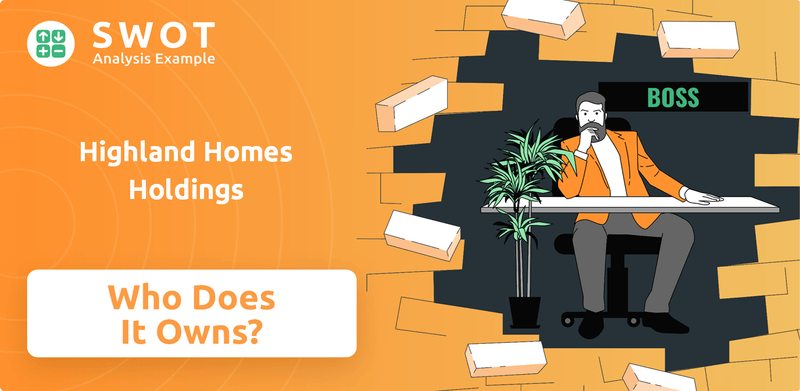
The journey of Highland Homes Holdings SWOT Analysis showcases a fascinating shift from founder-led to employee-owned status, impacting its governance and market approach. Understanding the details of Highland Homes ownership, including its executives and leadership team, provides valuable insights. This exploration aims to clarify the Highland Homes company structure, answering questions like "Who founded Highland Homes?" and "Who is the CEO of Highland Homes?" to offer a comprehensive view of this prominent homebuilder.
Who Founded Highland Homes Holdings?
The story of Highland Homes begins in 1985 with Rod Sanders and Jean Ann Brock, a brother-and-sister duo. They launched the company, initially funded by Sanders' 401K. This family-oriented approach has been a key aspect of the company's identity since its inception. The company's early success laid the groundwork for its expansion and growth in the Texas market.
Their first home was built in Rowlett, Texas, in 1986. Jean Ann Brock brought a fresh perspective to sales, marketing, and architecture, while Rod Sanders contributed his business acumen. Despite a challenging real estate market at the time, they managed to sell 13 homes in their first month of operation. This early achievement set a positive trajectory for the company.
By 1992, Highland Homes was already closing around 1,000 homes annually. The company's expansion continued, entering the Austin market in 1993, and by 2005, it had a presence in Dallas-Fort Worth, Houston, Austin, and San Antonio. The initial equity details and specific investor information are not publicly accessible, but the company has always emphasized its family-owned roots.
Highland Homes sold 13 homes in its first month, showing strong initial market performance.
By 1992, the company was closing approximately 1,000 homes annually, a significant increase from its early days.
Highland Homes expanded its operations across major Texas markets, including Austin, Dallas-Fort Worth, Houston, and San Antonio.
The company was founded by Rod Sanders and Jean Ann Brock, who brought complementary skills to the business.
The company has maintained a family-owned focus since its inception, influencing its culture and operations.
The initial funding came from Rod Sanders' 401K, highlighting the personal investment in the company's future.
It's important to differentiate this entity from another company also named 'Highland Homes' founded in Florida in 1996 by Robert J. and Joel Adams. This Florida-based company was acquired by Clayton Properties Group, a Berkshire Hathaway company, on May 3, 2019. The focus of this article is on the Texas-based Highland Homes Holdings Company, which is employee-owned. To understand more about the strategic direction of Highland Homes Holdings, you can read about the Growth Strategy of Highland Homes Holdings.
Highland Homes Holdings SWOT Analysis
- Complete SWOT Breakdown
- Fully Customizable
- Editable in Excel & Word
- Professional Formatting
- Investor-Ready Format
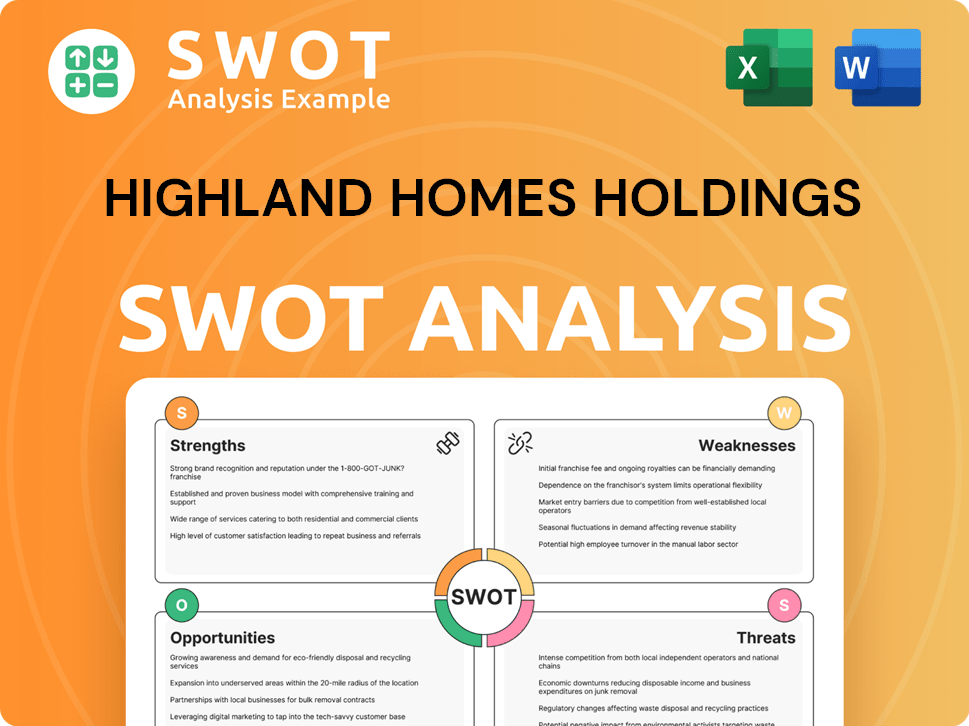
How Has Highland Homes Holdings’s Ownership Changed Over Time?
The most pivotal change in the ownership structure of Highland Homes Holdings happened in 2015. Founders Rod Sanders and Jean Ann Brock made a significant decision to transition the company to their employees. This move established an Employee Stock Ownership Plan (ESOP), making Highland Homes a 100% employee-owned entity. This shift was motivated by the founders' desire to preserve the company's culture, which prioritized customers, homeowners, and employees over a traditional sale to another corporation.
As of February 2025, Highland Homes continues to operate under this employee-owned model. This structure means that the employees are the primary stakeholders, sharing in the financial benefits upon retirement. This contrasts with publicly traded companies, where institutional investors, mutual funds, and individual shareholders hold significant stakes. It also differs from private companies backed by venture capital or private equity. The ESOP model at Highland Homes reinforces its people-first culture. In 2024, Highland Homes Holdings reported a revenue of $2.1 billion. The company closed on 3,876 homes in the previous year, a 69% increase from 2015. This employee-owned structure is designed to align employee interests with company performance, fostering a sense of collective ownership and responsibility for company strategy and governance.
Highland Homes' ownership structure is unique, with employees as the primary stakeholders. This model, established in 2015, emphasizes a people-first culture. The company's financial performance, including a $2.1 billion revenue in 2024, reflects the success of this approach. Learn more about the Target Market of Highland Homes Holdings.
- Highland Homes is 100% employee-owned.
- The ESOP model aligns employee interests with company performance.
- The company's revenue in 2024 was $2.1 billion.
- The founders prioritized culture over a traditional sale.
Highland Homes Holdings PESTLE Analysis
- Covers All 6 PESTLE Categories
- No Research Needed – Save Hours of Work
- Built by Experts, Trusted by Consultants
- Instant Download, Ready to Use
- 100% Editable, Fully Customizable
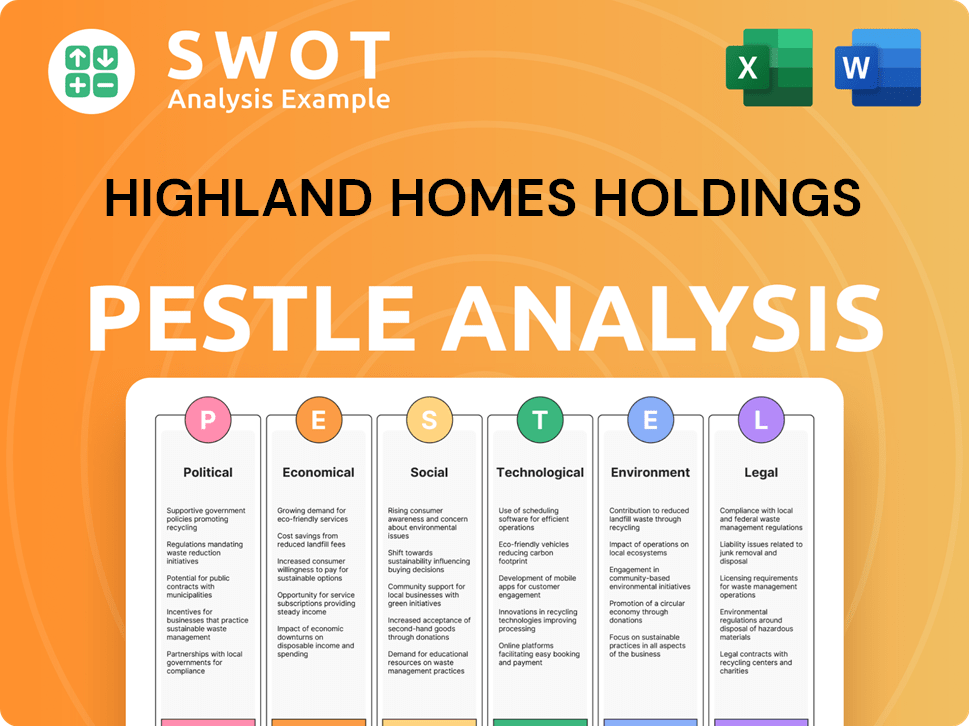
Who Sits on Highland Homes Holdings’s Board?
The board of directors for Highland Homes Holdings Company likely comprises representatives of its employee-owners and other individuals who offer strategic guidance. Because it is an employee-owned company, the board's primary responsibility is to oversee operations in the best interest of its employee-owners. Publicly available information does not provide a complete list of current board members or their specific affiliations.
The company's structure, as an ESOP, suggests that the board is structured to support the employee-owners. The founders, Rod Sanders and Jean Ann Brock, remained involved as employees, indicating their continued influence on leadership and strategic direction. The board's decisions are typically guided by the company's commitment to quality, customer satisfaction, and financial responsibility, as well as its focus on its team members.
| Aspect | Details | Notes |
|---|---|---|
| Board Composition | Likely includes employee-owner representatives and independent members. | Specific names and affiliations are not publicly available. |
| Governance Focus | Oversees operations in the best interest of employee-owners. | Emphasizes long-term value and employee well-being. |
| Influence of Founders | Rod Sanders and Jean Ann Brock remained involved post-ESOP. | Continued influence on leadership and strategic direction. |
The voting power within Highland Homes is distributed among the employees through their stock ownership, although the specific voting structure is not detailed in public records. This approach ensures employees have a vested interest and a voice in the company's future. The stable, internal-focused nature of Highland Homes, as an employee-owned enterprise, aligns with the absence of public records of recent proxy battles or governance controversies. For further insights, explore the Competitors Landscape of Highland Homes Holdings.
The board of directors at Highland Homes is designed to represent employee-owners. Voting power is distributed among employees through stock ownership, ensuring their voice in the company's future.
- Employee-owned structure.
- Focus on employee interests.
- Founders' continued influence.
- Stable governance.
Highland Homes Holdings Business Model Canvas
- Complete 9-Block Business Model Canvas
- Effortlessly Communicate Your Business Strategy
- Investor-Ready BMC Format
- 100% Editable and Customizable
- Clear and Structured Layout
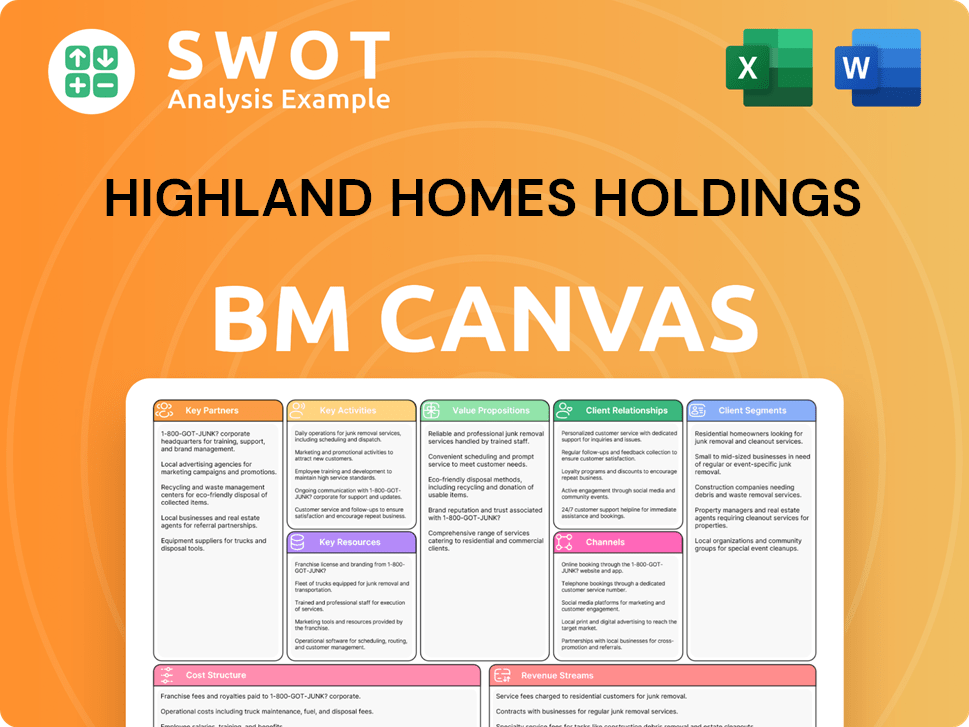
What Recent Changes Have Shaped Highland Homes Holdings’s Ownership Landscape?
Over the past few years, the ownership structure of Highland Homes has remained consistent, with the company continuing to operate under an employee stock ownership plan (ESOP). This model distinguishes Highland Homes from many competitors in the homebuilding industry. As of February 2025, the company is celebrating its 40th anniversary, a significant milestone in its history. In 2024, Highland Homes Holdings reported a revenue of $2.1 billion, demonstrating its strong financial performance. The company's commitment to its ESOP structure has played a key role in its stability and growth.
The homebuilding industry has seen trends of increased institutional ownership and consolidation. In 2024, the top 10 builders increased their market share to 60%. However, Highland Homes' ESOP, established in 2015, provides a different approach. This structure helps maintain a customer-focused culture, which is a strategic decision made by the founders. The company closed on 3,876 homes in the previous year, reflecting a 69% increase from 2015. The company's focus on strategic locations in high-growth markets, such as Dallas-Fort Worth and Houston, which saw a 3.5% increase in home sales in 2024, has also contributed to its success.
Highland Homes has expanded its offerings, providing homes from the $310,000s to over $1 million, with its Huntington Homes division offering properties from $1.5 million. There have been no public statements regarding privatization or public listing, reinforcing the ESOP structure's importance. This approach ensures cultural continuity and employee benefits, with leadership succession designed to be internal. For more insights, check out the Marketing Strategy of Highland Homes Holdings.
Highland Homes operates under an employee stock ownership plan (ESOP), distinguishing it from many competitors. This model ensures employee ownership and fosters a customer-focused culture. The ESOP structure is a deliberate choice to maintain cultural continuity.
In 2024, Highland Homes Holdings reported a revenue of $2.1 billion. The company closed on 3,876 homes, marking a 69% increase from 2015. These figures highlight the company's growth and financial stability.
The homebuilding industry is seeing increased institutional ownership and consolidation. The top 10 builders increased their market share to 60% in 2024. Highland Homes' ESOP provides a unique approach to ownership.
Highland Homes focuses on high-growth markets like Dallas-Fort Worth and Houston. Home sales in these areas saw a 3.5% increase in 2024. The company offers homes at various price points, expanding its market reach.
Highland Homes Holdings Porter's Five Forces Analysis
- Covers All 5 Competitive Forces in Detail
- Structured for Consultants, Students, and Founders
- 100% Editable in Microsoft Word & Excel
- Instant Digital Download – Use Immediately
- Compatible with Mac & PC – Fully Unlocked
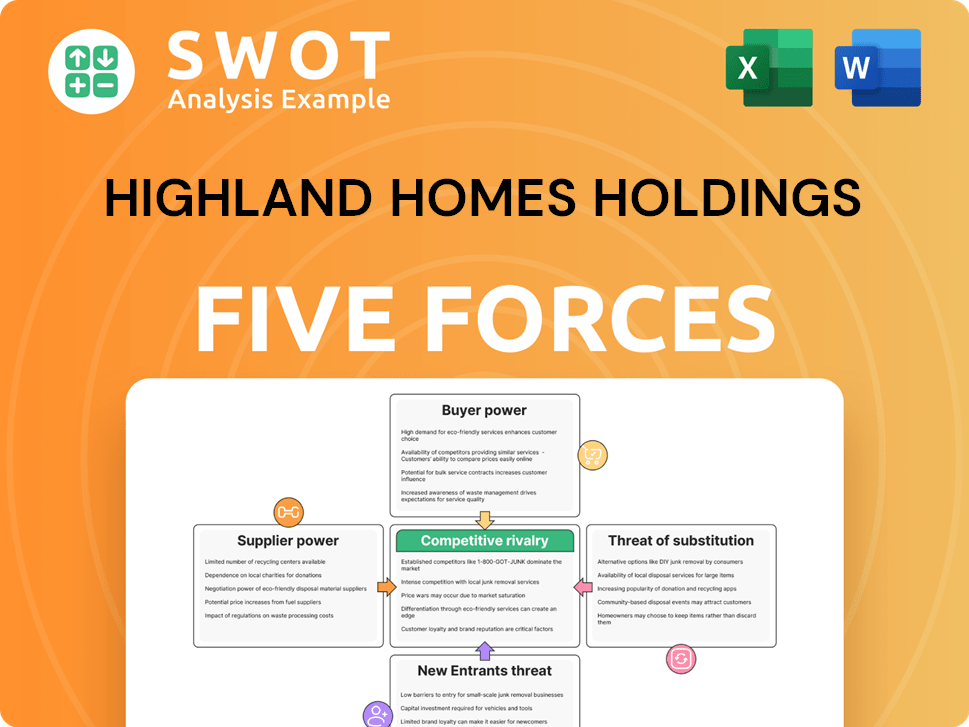
Related Blogs
- What are Mission Vision & Core Values of Highland Homes Holdings Company?
- What is Competitive Landscape of Highland Homes Holdings Company?
- What is Growth Strategy and Future Prospects of Highland Homes Holdings Company?
- How Does Highland Homes Holdings Company Work?
- What is Sales and Marketing Strategy of Highland Homes Holdings Company?
- What is Brief History of Highland Homes Holdings Company?
- What is Customer Demographics and Target Market of Highland Homes Holdings Company?
Disclaimer
All information, articles, and product details provided on this website are for general informational and educational purposes only. We do not claim any ownership over, nor do we intend to infringe upon, any trademarks, copyrights, logos, brand names, or other intellectual property mentioned or depicted on this site. Such intellectual property remains the property of its respective owners, and any references here are made solely for identification or informational purposes, without implying any affiliation, endorsement, or partnership.
We make no representations or warranties, express or implied, regarding the accuracy, completeness, or suitability of any content or products presented. Nothing on this website should be construed as legal, tax, investment, financial, medical, or other professional advice. In addition, no part of this site—including articles or product references—constitutes a solicitation, recommendation, endorsement, advertisement, or offer to buy or sell any securities, franchises, or other financial instruments, particularly in jurisdictions where such activity would be unlawful.
All content is of a general nature and may not address the specific circumstances of any individual or entity. It is not a substitute for professional advice or services. Any actions you take based on the information provided here are strictly at your own risk. You accept full responsibility for any decisions or outcomes arising from your use of this website and agree to release us from any liability in connection with your use of, or reliance upon, the content or products found herein.